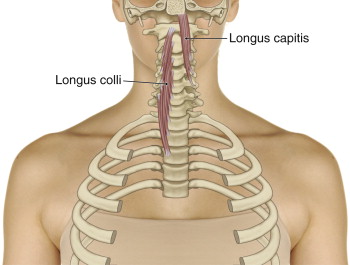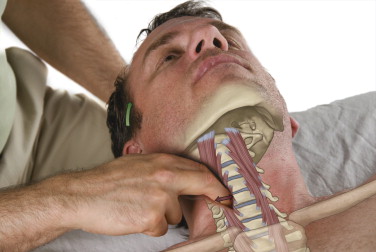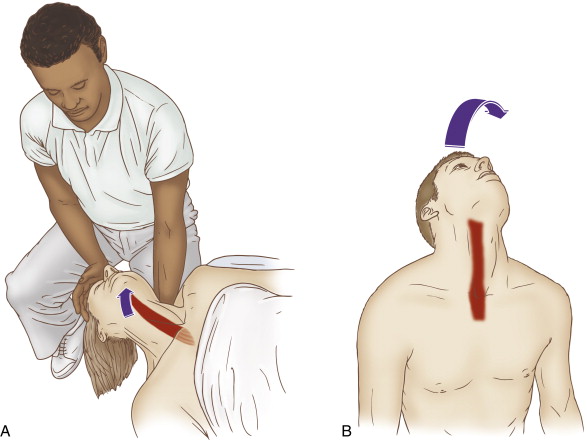Attachments and Actions of the Longus Colli and Longus Capitis
The longus colli and capitis are deep muscles of the anterior neck. As a group, they attach to the anterior bodies and transverse processes from T3 all the way to the cranium (Figure 17). Because they cross the cervical spinal joints anteriorly, they are flexors of the neck. Because they are located slightly laterally, they can also laterally flex the neck. Besides movement, they also function to stabilize the neck when swallowing.
Note: Spasmed musculature of the neck is understood to be extremely common, but we often think of the posterior musculature of the neck rather than the anterior musculature of the neck. However, due to common postural dysfunctional patterns, the longus muscles are often posturally locked short.

Figure 17. The right longus colli and left longus capitis. Courtesy of Joseph E. Muscolino. The Muscle and Bone Manual, with Trigger Points, Referral Patterns, and Stretching, 2ed. Elsevier 2016.
Palpation Assessment of the Longus Colli and Longus Capitis
The longus muscles are deep and located in a sensitive region of the body, but careful palpation can yield successful assessment and treatment of much of the musculature. To palpate them, first find the medial border of the sternocleidomastoid and then drop immediately medial to it. Before attempting to access the longus musculature, first feel for the pulse of the carotid artery. If the pulse is felt to be on either side of your finger tips, then continue the palpation by slowly and gently sinking in posteriorly toward the cervical spine. However, if the artery is felt to be directly in your path, then it might be necessary to palpate either medial or lateral to the artery and then sink posteriorly toward the longus musculature. Most often, palpation is effectively performed medial to the artery. One way to accomplish this is to displace the client’s larynx toward the opposite side of the body, and then sinking in posteriorly toward the spine. Because the larynx is a sensitive structure and pressure against it may initiate the cough reflex, this must be done extremely gently. We can tell that we have reached the longus musculature by feeling for the hardness of the cervical vertebrae directly deep to the muscle tissue. If we want confirmation that we are on the longus muscles, we can ask the client to engage the musculature by gently lifting the head toward the ceiling (Figure 18). Palpate as much of the longus musculature as possible. Once located, mild to at most moderate pressure can be applied to work them. Note: As with the sternohyoid, the anterior neck is a very sensitive region for many clients, so verbal consent should be attained before approaching this area; it is also important to check in often with the client regarding the depth of pressure. Also, because of the many sensitive structures located in the anterior neck, there are precautions that should be observed when working this region of the body.

Figure 18. Palpation of the right longus muscles. Note: Caution is advised when palpating the longus musculature that the carotid artery is not compressed. Courtesy of Joseph E. Muscolino. The Muscle and Bone Manual, with Trigger Points, Referral Patterns, and Stretching, 2ed. Elsevier 2016.
Stretching the Longus Colli and Longus Capitis
Together, the longus colli and longus capitis flex and laterally flex the head and neck at the spinal joints, so they are stretched by extending and laterally flexing the head and neck to the opposite side (Figure 19). Note: As with the sternohyoid, stretching the longus musculature by bringing the client’s neck into extension should not be done unless the vertebral artery competency test (VACT) has first been performed.

Figure 19. Stretching the right longus muscles, therapist-assisted (A) and self-care (B). Note: Caution is advised whenever bringing the client’s head down into extension. Courtesy of Joseph E. Muscolino. The Muscle and Bone Manual, with Trigger Points, Referral Patterns, and Stretching, 2ed. Elsevier 2016.
Case Study – Longus Colli and Longus Capitis
Andrew was a 45 year-old fast-paced executive who presented with pain in the anterior neck. He said that the pain had begun approximately 12 months before and that there was no precipitating trauma that he recalled; the pain began insidiously and had steadily increased over time. Although there did not seem to be a consistent pattern to when the pain was felt, he most often experienced it when swallowing. He stated that he had been to multiple medical doctors ruling out most every possible pathologic condition of the chest, neck, and throat. Nothing had been found. Needless to say, Andrew was quite concerned about the cause of his pain. I examined all the joints and musculature of his neck. Although he did have tight musculature in his posterior neck, palpation and engagement of this musculature did not reproduce his characteristic pain pattern. However, when I palpated anteriorly into his longus musculature, he immediately felt the pain that he had been experiencing for the past year or so. He had tight longus musculature. When I explained to Andrew what the cause of his pain was, he was greatly relieved to find out that his condition was not life-threatening in any way. Because of his priority of working and knowing that the condition was not dangerous, he declined to come in for a regimen of treatment because of the time it would take away from his work. In lieu of treatment, I advised him to gently massage and stretch the area. I never saw Andrew again, but his wife who was a regular patient of mine, reported to me that over the course of a few months, his pain had gradually dissipated.
Note: This blog post article is the seventh in a series of 8 posts on
Unusual Suspect Muscles of the Body*
The 8 Blog Posts in this Series are:
- Introduction
- Palmar Interossei (PI)
- Flexor Pollicis Longus (FPL)
- Quadratus Femoris (QF)
- Coccygeus & Levator Ani
- Sternohyoid
- Longus Colli & Longus Capitis
- Other Unusual Suspects…
* This series of blog post articles is modified from an article originally published in massage and bodywork (m&b) magazine: The Unusual Suspects. November/December 2016 issue.


